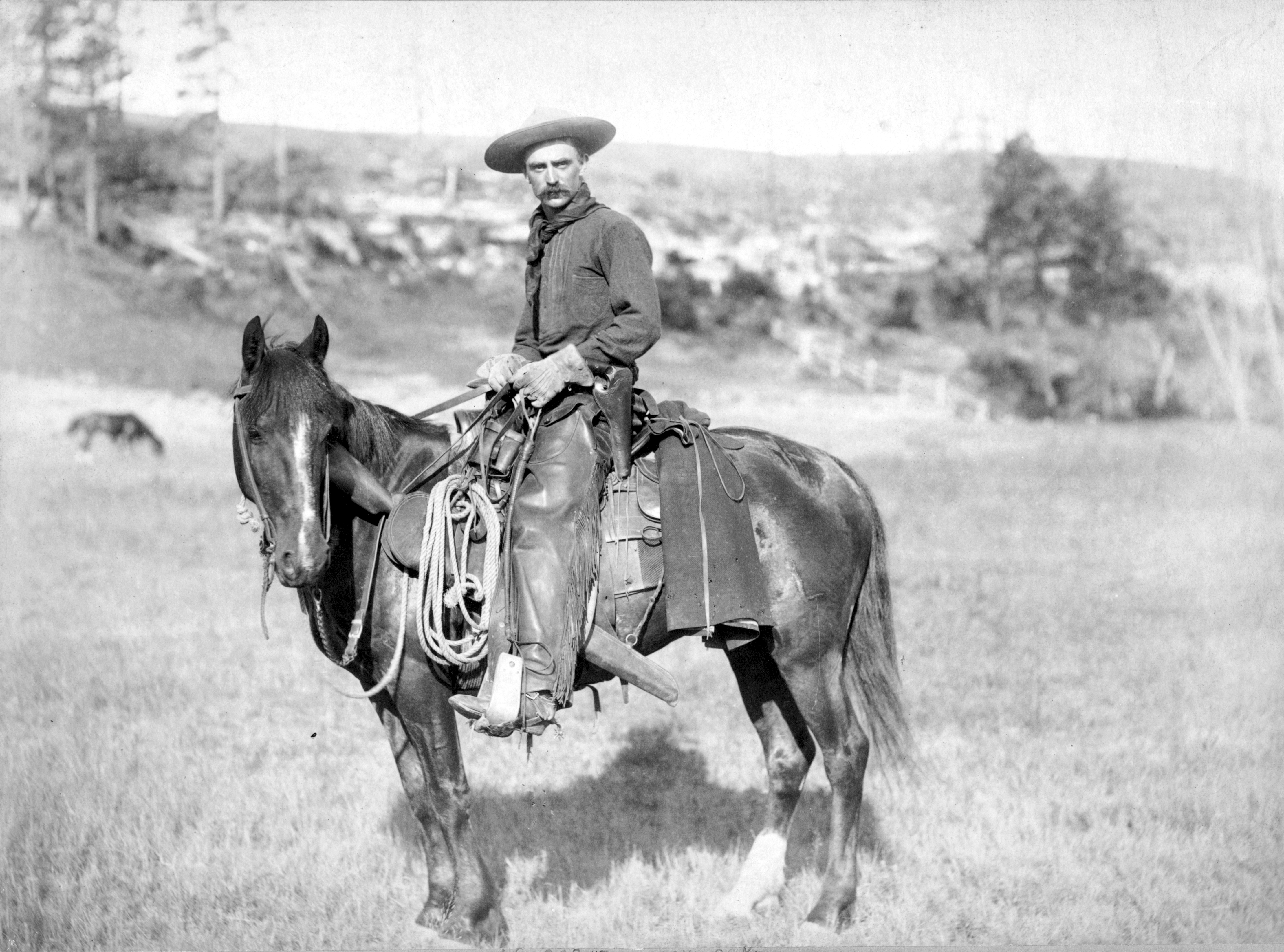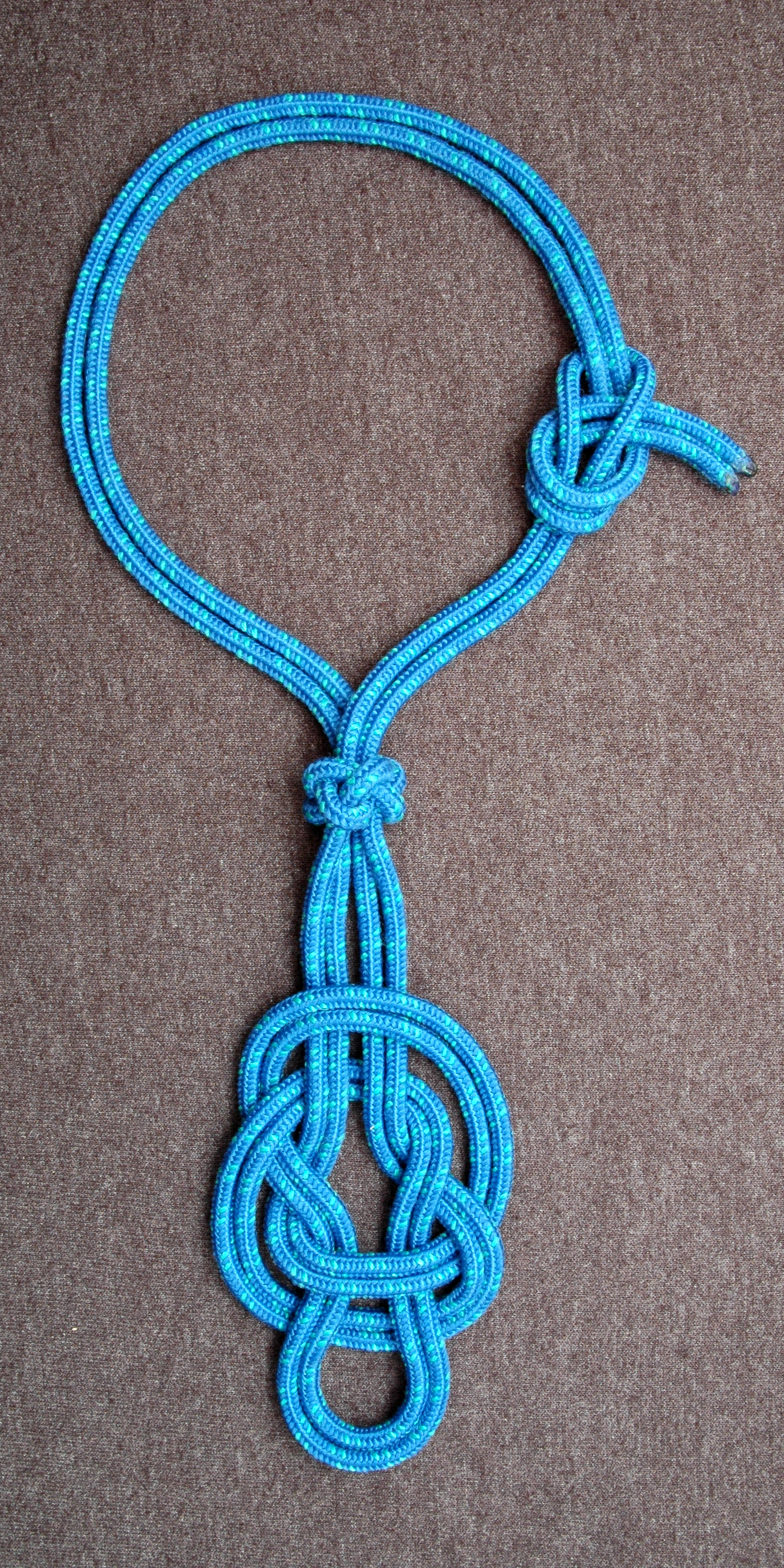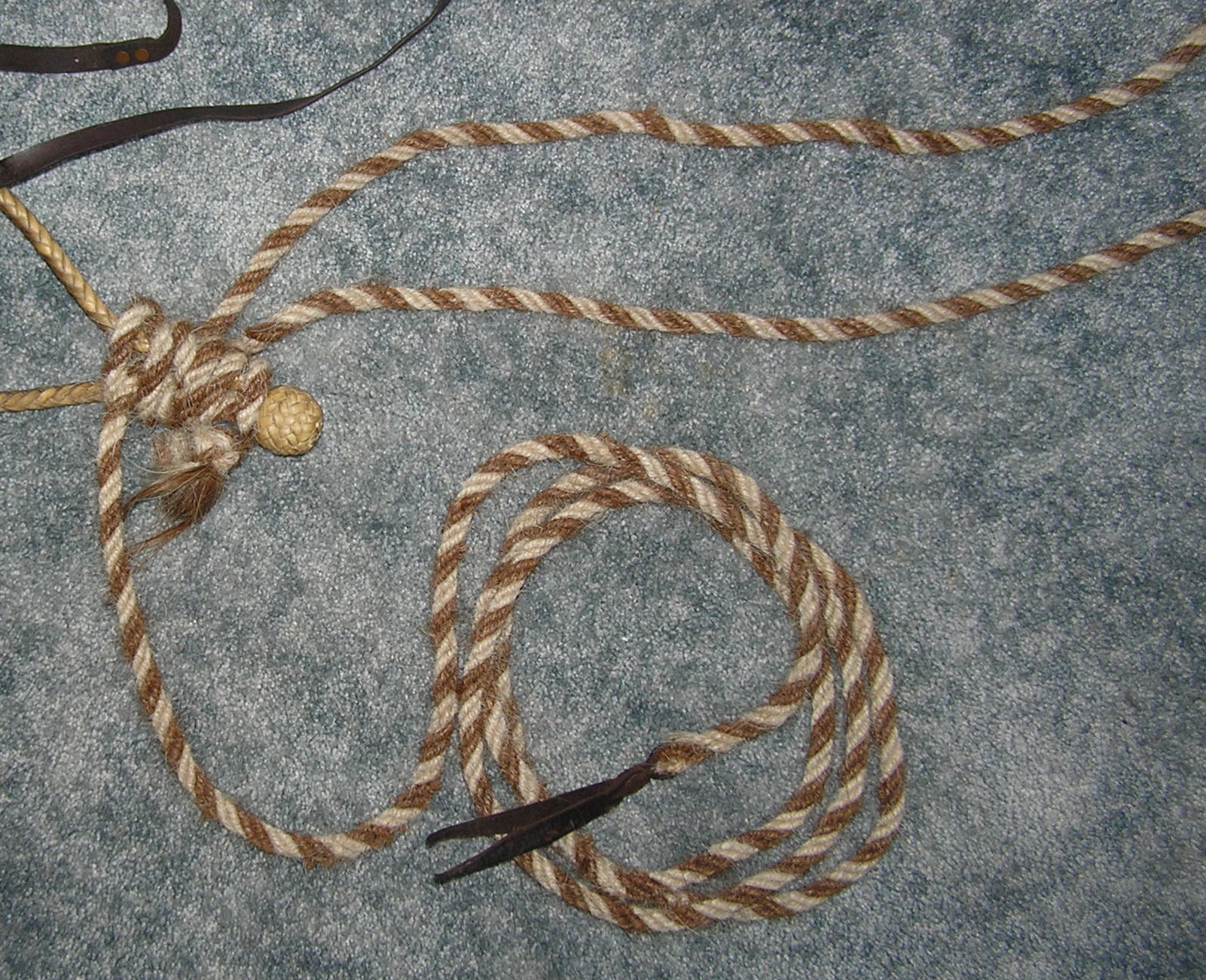|
Fiador (tack)
A fiador () term of Spanish colonial origin referring to a hackamore component used principally in the Americas. In English-speaking North America, the fiador is known principally as a type of throatlatch used on the bosal-style hackamore. Its purpose is to stabilize a heavy noseband or bosal and prevent the bridle from shifting. It is not used for tying the horse. A fiador-like design and fiador knot is also used under the jaw on some rope halters, usually ending in a loop to which a lead rope can be attached. This, however, is not an independent "fiador", nor generally labeled as such; it is simply an integral part of the halter itself. Origins The origin of the word ''fiador'' in its equestrian sense is obscure but appears to be of South American origin. In Spanish, the word ''fiador'' has numerous senses, all related to safekeeping. For example, an 18th-century Spanish—English dictionary defines ''fiador'' as ''surety, bail; he that is bound for another. In falconry, ... [...More Info...] [...Related Items...] OR: [Wikipedia] [Google] [Baidu] |
Bosal On Horse
A bosal (, , or ) is a type of noseband used on the classic hackamore of the ''vaquero'' tradition. It is usually made of braided rawhide (textile), rawhide and is fitted to the horse in a manner that allows it to rest quietly until the rider uses the reins to give a signal. It acts upon the horse's nose and jaw. Though seen in both the "Texas" and the "California" cowboy traditions, it is most closely associated with the "California" style of western riding.Price, Steven D. (ed.) ''The Whole Horse Catalog: Revised and Updated'' New York:Fireside 1998 p. 158-159 Sometimes the term ''bosal'' is used to describe the entire classic hackamore or ''jaquima.'' Technically, however, the term refers only to the noseband portion of the equipment. Bosals come in varying diameters and weights, allowing a more skilled horse to "graduate" into ever lighter equipment. Once a young horse is solidly trained with a bosal, a bit (horse), bit is added and the horse is gradually shifted from th ... [...More Info...] [...Related Items...] OR: [Wikipedia] [Google] [Baidu] |
Noseband
A noseband is the part of a horse's bridle that encircles the nose and jaw of the horse. In English riding, where the noseband is separately attached to its own headstall or crownpiece, held independently of the bit, it is often called a cavesson or caveson noseband. In other styles of riding, a simple noseband is sometimes attached directly to the same headstall as the bit. Development A noseband may have been one of the first tools used by humans to domesticate and ride horses. The bit developed later. The noseband was originally made of leather or rope. After the invention of the bit, the noseband was, in some cultures, demoted to a halter worn beneath the bridle that allowed the rider to remove the bit from the horse's mouth after work and leave a restraining halter on underneath, or to tie the horse by this halter, instead of by the bit, which could result in damage to the horse's mouth if it panicked. However, its ability to hold a horse's mouth shut over the bit was also ... [...More Info...] [...Related Items...] OR: [Wikipedia] [Google] [Baidu] |
Spain
, image_flag = Bandera de España.svg , image_coat = Escudo de España (mazonado).svg , national_motto = ''Plus ultra'' (Latin)(English: "Further Beyond") , national_anthem = (English: "Royal March") , image_map = , map_caption = , image_map2 = , capital = Madrid , coordinates = , largest_city = Madrid , languages_type = Official language , languages = Spanish language, Spanish , ethnic_groups = , ethnic_groups_year = , ethnic_groups_ref = , religion = , religion_ref = , religion_year = 2020 , demonym = , government_type = Unitary state, Unitary Parliamentary system, parliamentary constitutional monarchy , leader_title1 = Monarchy of Spain, Monarch , leader_name1 = Felipe VI , leader_title2 = Prime Minister of Spain ... [...More Info...] [...Related Items...] OR: [Wikipedia] [Google] [Baidu] |
Frentera
A frentera is a part of some halters and bridles, usually on a horse. It is a cord, strap, or chain on the face of the horse that is attached to the crownpiece or browband and runs down the horse's face to the noseband or bit rings. A frentera can be split at the top to pass on either side of the forelock, or on either side of the ears. In the latter case, the frentera usually substitutes for a browband. A frentera can also be split at the bottom into two or more parts to support and stabilize a heavy noseband or bit. The known history of the frentera dates back to Ancient Greece, possibly earlier, and the frentera is in use today in Europe, Asia, Australia, and South America. When it includes a disk or sheet of metal, often silver, it is known in English as a testera (Spanish loanword), chamfron ( French loanword), or faceplate. Equipment with a similar purpose of stabilizing a bit or noseband include the forelock hanger (North America), bit lifter (Australia), and cheekers ... [...More Info...] [...Related Items...] OR: [Wikipedia] [Google] [Baidu] |
Bridle
A bridle is a piece of equipment used to direct a horse. As defined in the ''Oxford English Dictionary'', the "bridle" includes both the that holds a bit that goes in the mouth of a horse, and the reins that are attached to the bit. Headgear without a bit that uses a noseband to control a horse is called a hackamore, or, in some areas, a bitless bridle. There are many different designs with many different name variations, but all use a noseband that is designed to exert pressure on sensitive areas of the animal's face to provide direction and control. Parts The bridle consists of the following elements: * Crownpiece: The crownpiece, headstall (US) or headpiece (UK) goes over the horse's head just behind the animal's ears, at the poll. It is the main strap that holds the remaining parts of the bridle in place. * Cheekpieces: On most bridles, two cheekpieces attach to either side of the crownpiece and run down the side of the horse's face, along the cheekbone and attach to the ... [...More Info...] [...Related Items...] OR: [Wikipedia] [Google] [Baidu] |
Argentina
Argentina (), officially the Argentine Republic ( es, link=no, República Argentina), is a country in the southern half of South America. Argentina covers an area of , making it the second-largest country in South America after Brazil, the fourth-largest country in the Americas, and the eighth-largest country in the world. It shares the bulk of the Southern Cone with Chile to the west, and is also bordered by Bolivia and Paraguay to the north, Brazil to the northeast, Uruguay and the South Atlantic Ocean to the east, and the Drake Passage to the south. Argentina is a federal state subdivided into twenty-three provinces, and one autonomous city, which is the federal capital and largest city of the nation, Buenos Aires. The provinces and the capital have their own constitutions, but exist under a federal system. Argentina claims sovereignty over the Falkland Islands, South Georgia and the South Sandwich Islands, and a part of Antarctica. The earliest recorded human prese ... [...More Info...] [...Related Items...] OR: [Wikipedia] [Google] [Baidu] |
Western Riding
Western riding is considered a style of horse riding which has evolved from the ranching and welfare traditions which were brought to the Americas by the Spanish Conquistadors, as well as both equipment and riding style which evolved to meet the working needs of the cowboy in the American West. At the time, American cowboys had to work long hours in the saddle and often over rough terrain, sometimes having to rope a cattle using a lariat, also known as a lasso. Because of the necessity to control the horse with one hand and use a lariat with the other, western horses were trained to neck rein, that is, to change direction with light pressure of a rein against the horse's neck. Horses were also trained to exercise a certain degree of independence in using their natural instincts to follow the movements of a cow, thus a riding style developed that emphasized a deep, secure seat, and training methods encouraged a horse to be responsive on very light rein contact. There are significan ... [...More Info...] [...Related Items...] OR: [Wikipedia] [Google] [Baidu] |
Vaquero
The ''vaquero'' (; pt, vaqueiro, , ) is a horse-mounted livestock herder of a tradition that has its roots in the Iberian Peninsula and extensively developed in Mexico from a methodology brought to Latin America from Spain. The vaquero became the foundation for the North American cowboy. The ''vaqueros'' of the Americas were the horsemen and cattle herders of New Spain, who first came to California with the Jesuit priest Eusebio Kino in 1687, and later with expeditions in 1769 and the Juan Bautista de Anza expedition in 1774. They were the first cowboys in the region. In Alberta, Northern Mexico, and the Southwestern United States, especially in Texas the remnants of major and distinct ''vaquero'' traditions remain, most popular today as the Californio, Neomexicano, and Tejano traditions. In Central and South America, there are similar, related traditions. The cowboys of the Great Basin still use the term " buckaroo", which may be a corruption of ''vaquero'', to describe themse ... [...More Info...] [...Related Items...] OR: [Wikipedia] [Google] [Baidu] |
Becket Hitch
A becket hitch, including the double becket or figure-of-eight becket hitch, is any hitch that is made on an eye loop, i.e. on a becket."Marlinspike Seamanship", Ship468.org, 2008, webpag ship468-AP5. "Becket hitch", ''The Illustrated Encyclopedia of Knots'', 2007, page 59, Google Books webpage: -->lpg=PA59=book_result&ct=result&resnum=2 GBooks-diG see image on page, showing 2 bends in figure-of-eight line. A becket hitch has the same structure as the sheet bend, which joins, or "bends", the ends of two ropes together. The becket hitch, in contrast, fixes a rope to a closed eye or hook. In this instance, a ''becket'' means the eye or hook of a pulley block, an eye in the end of a rope, or a rope handle on a sailor's sea chest. Tying For greater security, an additional round turn may be taken above the first before the line's working end is brought back under itself, creating a double becket or figure-of-eight becket. In the figure-of-eight becket hitch, the working end ... [...More Info...] [...Related Items...] OR: [Wikipedia] [Google] [Baidu] |
Bottle Sling
The bottle sling (also called a jug sling, a Hackamore knot, or a Scoutcraft knot) is a knot which can be used to create a handle for a glass or ceramic container with a slippery narrow neck, as long as the neck widens slightly near the top. While classed with binding knots, such as the reef knot and miller's knot, the bottle sling is able to perform a function for which most other binding knots are unsuited. The bottle sling's specific form allows it to grip a cylinder, assuming it has even a slight flare or collar, and lift it along its axis when the knot is loaded by all four strands. With appropriate size cord, most wine bottles can be reliably suspended with this knot. History The bottle sling was described in detail by the Greek physician Heraklas in his first century monograph on surgical knots and slings. It was included under the name ''diplous karkhesios brokhos'' ("double jug-sling noose"). Clearly familiar with the knot, Heraklas provided three distinct tying m ... [...More Info...] [...Related Items...] OR: [Wikipedia] [Google] [Baidu] |
Matthew Walker Knot
A Matthew Walker knot is a decorative knot that is used to keep the end of a rope from fraying. It is tied by unraveling the strands of a Rope#Twisted Ropes and Hawsers, twisted rope, knotting the strands together, then laying up the strands together again. It may also be tied using several separate cords, in which case it keeps the cords together in a bundle. The traditional use of the knot is to form a knob or "stopper" to prevent the end of the rope from passing through a hole, for instance in rigging the lanyards which tension the shrouds on older sailing ships with standing rigging of fibre cordage. It is not specifically known who Matthew Walker was, nor why this knot was named after him. However, early references from the 19th century suggest he may have been a ship's rigger in the Royal Navy. The following quote from ''The Ashley Book of Knots'' gives possible origins of the knot: The FULL or DOUBLE MATTHEW WALKER KNOT. Lever in 1808 speaks of "MATTHEW WALKER'S KNOT" a ... [...More Info...] [...Related Items...] OR: [Wikipedia] [Google] [Baidu] |
Mecate (rein)
The mecate ( or less anglicized ; ) is the rein system of the bosal style hackamore used to train young horses. It is a long rope, traditionally of horsehair, approximately 20–25 feet long and up to about 3/4 inch in diameter. It is tied to the bosal in a specialized manner that adjusts the fit of the bosal around the muzzle of the horse, and creates both a looped rein and a long free end that can be used for a number of purposes. When a rider is mounted, the free end is coiled and attached to the saddle. When the rider dismounts, the lead rein is not used to tie the horse to a solid object, but rather is used as a lead rope and a form of Longe line when needed.Price, 158 The traditional mecate was an integral part of the ''vaquero'' culture that became the California tradition of western riding. The classic mecate is hand-braided of horsehair, usually long hair from the tail, often a blend of black and white hairs made into an alternating design. Modern mecates are made n ... [...More Info...] [...Related Items...] OR: [Wikipedia] [Google] [Baidu] |







